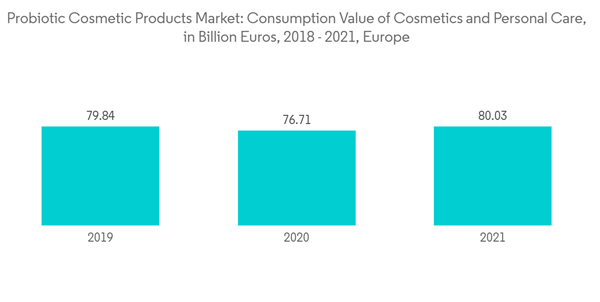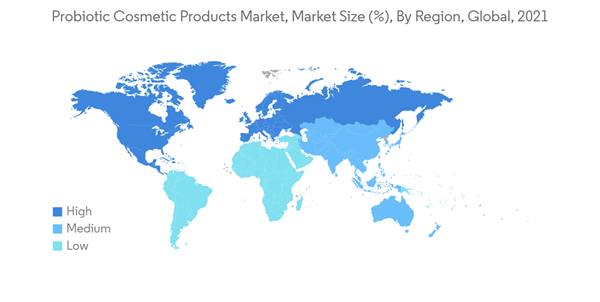The Probiotic Cosmetic Products Market size is estimated at USD 16.42 billion in 2024, and is expected to reach USD 21.67 billion by 2029, growing at a CAGR of 5.71% during the forecast period (2024-2029).
This product will be delivered within 2 business days.
Key Highlights
- The rise in popularity of probiotics as a main functional ingredient is significant because of their efficiency against various skin concerns, such as acne, wrinkle, and blemishes which are anticipated to drive market growth during the study period. Furthermore, a rise in demand for natural cosmetics among various consumer groups, particularly millennials, supported by growing awareness about their clinical evidence and efficacy, has also increased the market's growth.
- Owing to the growing demand for products with natural ingredients and due to a shift towards sustainable raw materials, manufacturers of conventional cosmetics and personal care products are also introducing products with more natural ingredients, like probiotics. Future product launches are predicted to shift as a result of this trend.
- Additionally, catering to the demand, new probiotic ingredients are being launched by manufacturers specifically to use in cosmetic products. For instance, in April 2022, Probi (Lund, Sweden), in collaboration with Symrise, created a new skincare ingredient, SymFerment, a moisturizing active ingredient that the company claims is based on a byproduct of Probi's probiotic that is produced by the fermentation of Lactiplantibacillus (Lactobacillus).
- Moreover, factors such as growth in personal appearance, skin, hair, health, and wellness coupled with demand for multi-functional beauty products, which allow consumers to extract maximum value by spending on a single development, are the key trends expected to drive the probiotic cosmetic products market in the coming years.
- Also, as people spend time on social media and many fashion and skincare influencers burst onto the scene, brands could proliferate their digital presence with partnerships and increase their brand equity through promotions. This, in turn, is increasing traffic to the company websites and allowing cosmetic brands to sell direct-to-consumer with minimal focus on logistics.
Probiotic Cosmetic Products Market Trends
Increasing Demand For Multi-functionality products
- There has been an increase in demand for specialized products, including serums and creams containing probiotic skincare solutions and having multifunctional features. The young and the old population are interested in buying them because the products target common issues like wrinkles, skin tone, inflammation, and acne.
- A single cosmetic product that offers several benefits is becoming increasingly popular due to its multifunctionality, which helps consumers get the most bang for their buck with each purchase. Also, such products come in handy while traveling as they become easy to carry, reduce waste, and save money.
- Using multifunctional products is also an eco-friendly practice as it reduces plastic waste. Utilizing things with several uses helps prevent plastic waste, which is another eco-friendly approach. These factors are anticipated to drive the sales of such products, thereby boosting the growth of the entire market during the forecast period. Women are increasingly turning to multipurpose solutions with several skincare benefits because they save consumers' time and effort and make it simpler to select the best options for various uses.
- For instance, according to Cosmetica Italia, the consumption value of cosmetics and personal care products reached 79.84 billion euros (USD 85.43 billion) in 2019 and over 80 billion euros (USD 85.25 billion) in 2021. Germany consumed the largest cosmetics in 2021, valued at approximately 13.6 billion euros (USD 16.41 billion). This was followed by France and Italy, at about 12 billion euros (USD 12.72 billion) and 10.6 billion euros (USD 11.256), respectively.
- Additionally, consumers continuously seek skincare products with pure organics, such as probiotics. Furthermore, product innovation and launches will drive market growth in the coming years. For instance, in 2021, Shielded Beauty launched its skincare collection specific to improving skin health and nourishing the microbiome. Night Life "Live" Probiotic + HASerum is one of the products launched by the company, which is claimed to include live pre-and probiotics to build the skin's barrier.
North America Holds Significant Share in the Market
- North America has witnessed an increase in the percentage of the population inclined towards healthier lifestyles, supported by a rise in demand for products that have a low impact on the environment are the major factors driving the market growth in the region. Additionally, the growing acceptance of probiotic products, including cosmetics, especially among millennials, will likely contribute to the market's growth in the coming years.
- Furthermore, awareness about the harmful effects of chemicals and synthetic products are a few factors enhancing the market's growth. As individuals become more aware of the risks posed by synthetic chemical items, they are avoiding utilizing products that include chemicals. The harmful effects on skin brought on by a few less expensive chemical product variants have raised consumer knowledge in the region and helped people comprehend the link between health and natural products, increasing demand for natural goods like probiotic cosmetics.
- In line with these factors and the growing demand for such natural and environmentally friendly products in the regions, many players are expanding their businesses into the region and launching new products to attract consumers and grab a significant market share.
- For instance, in August 2021, one of the top clean clinical skincare companies, TULA Skincare powered by probiotic extracts and superfoods, announced that it expanded its presence in North America by entering the Canadian market through Sephora.
Probiotic Cosmetic Products Industry Overview
The probiotic cosmetics market is fragmented, with various regional and global players. Companies are investing in expanding their product offerings, improving functionality, and marketing activities. Due to constantly changing consumer preferences, firms must continue to innovate, operate, and develop in the market. Furthermore, organizations leverage digital and social media to promote new products and gain market share. Key players in the market include Esse Skincare, L'Oreal S.A., Unilever PLC, Estée Lauder Inc., and H&H Group.Additional Benefits:
- The market estimate (ME) sheet in Excel format
- 3 months of analyst support
This product will be delivered within 2 business days.
Table of Contents
1 INTRODUCTION
4 MARKET DYNAMICS
5 MARKET SEGMENTATION
6 COMPETITIVE LANDSCAPE
Companies Mentioned (Partial List)
A selection of companies mentioned in this report includes, but is not limited to:
- L'Oreal S.A.
- Esse Skincare
- Unilever PLC
- Estee Lauder Inc
- H&H Group
- Eminence Organic Skin Care
- The Clorox Company
- Andalou Naturals
- Tula Life Inc.
- LaFlore Probiotic Skincare
Methodology

LOADING...










